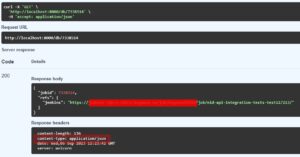To summarize this comparison in a table, you might use
subtract()
function, which gives rows present in one dataframe but not in another. Then convert the resulting DataFrame into HTML using Pandas DataFrame’s
to_html
method. Note, subtract doesn’t perform row-wise subtraction, it helps identify unique records.
Here is a simple example:
# Compare the dataframes difference_df = df1.subtract(df2) # Convert the result to pandas dataframe pandas_difference_df = difference_df.toPandas() # Generate HTML table html_table = pandas_difference_df.to_html()
Now let me explain this snippet.
The `subtract` method will get all the rows from df1 that are not available in df2. This is how we obtain all the unique records between two PySpark dataframes. As a result, difference_df now contains all the rows where df1 and df2 differ.
We then converted the obtained Spark DataFrame to a Pandas DataFrame because it’s more comfortable to work with, particularly when generating HTML tables.
Finally, we’ve converted the pandas DataFrame to HTML format using the
to_html()
function, which produces an HTML string of the table.
The major takeaway here is the usage of the
subtract()
function to find unique records between PySpark data frames and then using pandas for easy conversion to an HTML table.
In real-world applications, PySpark is commonly used in big data processing due to its ability to handle large volumes of data. By understanding how to compare two DataFrames effectively, you can reveal useful insights and differences that may be crucial in further analysis or decision making.
Remember, when working with large datasets, PySpark performs better than traditional Python libraries like pandas due to its distributed computing features. The transition from PySpark DataFrame to pandas should be made thoughtful and limited to small results to avoid memory issues in your pipelines.
For a detailed read on handling large datasets with PySpark, check out Apache PySpark Documentation.
I hope this helps in comparing two DataFrames using PySpark and producing the differences in a readable HTML format. Happy Coding!
In order to compare two data frames in PySpark, it is crucial to have a fundamental understanding of the sequence of RDD (Resilient Distributed Dataset), which is the basic data structure in Spark. RDDs are immutable distributed collections of objects that can be processed in parallel. A DataFrame in Spark is essentially a distributed collection of data organized into named columns.
DataFrames are conceptually similar to a table in a relational database or a data frame in R or Python. They support a broad range of functions such as filtering, aggregating, or computing statistics over the data.
Examining the basics of DataFrames from a coder perspective:
• DataFrames are designed for processing large volumes of structured or semi-structured data. Observations (i.e., rows) in SparkDataFrames are grouped together to optimize computation costs.
• They allow developers to impose a structure onto a distributed collection of data, allowing for higher level abstractions.
• It facilitates seamless interoperation between multiple languages and its API is also available in Scala, Java, Python, and R.
To draw a comparison between two DataFrames in PySpark, you must understand how to create DataFrames, select particular columns, filter DataFrame based on conditions, calculate statistical measures, and even convert DataFrame format to other like RDD, dense vector, etc.
Now, let’s say we have two DataFrames,
df1
and
df2
, and we want to see if they are equal. Here, ‘equal’ means both DataFrames have the same column names, column types, and identical rows regardless of their ordering. We can use the
.exceptAll()
method in PySpark SQL. It returns a new DataFrame containing rows in
df1
but not in
df2
.
Code:
difference_df = df1.exceptAll(df2)
equal_df = difference_df.rdd.isEmpty()
Here,
rdd.isEmpty()
returns True if there is no difference, meaning both data frames are same.
However, you must note that comparing entire dataframes can be computationally expensive, especially with large datasets. Consider more targeted methods of dataset comparison if feasible, such as using keys that identify data uniquely across both dataframes.
It’s also essential to keep in mind the possibility of null data when comparing dataframes. Make sure to clean or process these data points accordingly before performing a comparison to prevent inaccurate results.
For an elaborate guide about Data Frames in PySpark, you can refer to this official documentation.Let’s tackle this by exploring the various PySpark methods that allow us to compare two or more dataframes.
Using the subtract() Method
The
subtract()
method is an effective tool for dataframe comparison. It returns a new dataframe with rows that are in one dataframe but not the other dataframe.
Here’s a sample code snippet:
# Sample dataframes df1 = spark.createDataFrame([(1, "foo"), (2, "bar")], ["id", "value"]) df2 = spark.createDataFrame([(1, "foo")], ["id", "value"]) # Subtract df2 from df1 diff_df = df1.subtract(df2) diff_df.show()
This script will return rows that are in df1 not available in df2.
However, subtract works based on matching all columns and it won’t consider any column individually. In case you want to compare specific columns, you might have to use the join operation.
Using Join Operations
Join operations also facilitate our endeavor of comparing two dataframes. Consider this example that shows how to get rows available in one dataframe but not the other:
# Using left_anti join diff_df = df1.join(df2, ["id","value"], 'left_anti') diff_df.show()
In the opposite way, if you want to find out the common records between two dataframes, you can leverage the ‘inner’ join operation:
# Inner join to fetch common records common_df = df1.join(df2, ["id", "value"], 'inner') common_df.show()
The challenge with using joins, like subtract(), is that they operate over all columns, unless we specify them explicitly.
Please remember that these comparisons are case-sensitive so be sure to account for that when comparing string-type fields.

Using ExceptAll()
To compare the difference between two DataFrames you can use the `exceptAll` command which will return all rows from df1 except ones that exist in df2:
diff_df = df1.exceptAll(df2) diff_df.show()
Remember that `exceptAll` does not remove duplicate rows. So if a row occurs two times in df1 and one time in df2, one occurrence will still remain in the result DataFrame.
I hope that gives you various ways of comparing Spark dataframes. Before you implement these in your projects, I encourage you to go ahead and play around with some sample dataframes and see how they work. For more information about DataFrame operations on PySpark, here’s the online documentation.In PySpark, comparing two DataFrames includes taking care of missing values. Here’s how to do it:
Begin with two DataFrames, df1 and df2 that are being compared as:
from pyspark.sql import SparkSession
spark = SparkSession.builder.getOrCreate()
data1 = [("John", "Doe", 30), ("Jane", "Doe", None)]
df1 = spark.createDataFrame(data1, ["FirstName", "LastName", "Age"])
data2 = [("John", "Doe", 30), ("Jane", "Doe", 25)]
df2 = spark.createDataFrame(data2, ["FirstName", "LastName", "Age"])
While comparing these DataFrames, you’ll encounter ‘None’, which signifies a missing value in PySpark.
There’s a common challenge while dealing with missing values during DataFrame comparison in PySpark. If a DataFrame has null values, the standard way of DataFrame comparison using equals (==) will not work as expected. This is mainly because ‘None’ is never equivalent to any value including ‘None’ itself.
For instance, look at this code snippet which compares two dataframes using
equals()
function.
df1.equals(df2)
Here, since there’s a missing value in our df1 DataFrame,
equals()
function should return false as the result.
An efficient way to handle this issue is to fill in the missing values using `fillna()` before DataFrame comparison. It implies substituting the missing values with a predefined value.
For numerical columns, the usual practice is to replace them with 0 or mean/median of the column. For categorical columns, usually None.
The syntax for using
fillna()
function is:
dataframe.fillna(value, subset=None)
The ‘value’ is the Value to replace null values with. If the value is a dict, then subset is ignored and value must be a mapping from column name (string) to replacement value. The ‘subset’ parameter specifies the optional list of column names to consider.
So in order to fill the missing age of Jane Doe with 0 in our df1 DataFrame we can simply use:
df1 = df1.fillna({"Age": 0})
Drawback: The only shortcoming of this method is, the real analysis may get hindered if the substituted value affects the overall statistics of the data like mean, median, etc.
However, after performing this operation, direct DataFrame comparison using
equals()
function can now give expected results:
df1.equals(df2)
This will now return False, indicating the updated df1 does not equal to df2.
The ultimate solution to handling missing data solely depends on the nature of the data and the intended analysis.
References:
1. PySpark FillNa Function
2. PySpark Equals FunctionTo compare two PySpark dataframes and detect differences between them, we first need to set conditions that define what a ‘difference’ would be in our context. For instance, are we looking for differences in exact rows, differences on a column basis, or are we interested in understanding if one dataframe holds records the other one does not have?
Let’s illustrate this scenario with some practical examples.
Example 1: Detect Complete Row Differences
We’re going to be using PySpark methods like
subtract()
, which returns a new DataFrame containing rows in dataframe1 but not in another dataframe2:
import pyspark.sql
# Creating Spark Session
spark = pyspark.sql.SparkSession.builder.getOrCreate()
# Sample DataFrames
df1 = spark.createDataFrame([(1, "foo"),
(2, "bar"),
(3, "baz")], ["ID", "Type"])
df2 = spark.createDataFrame([(1, "foo"),
(2, "bat")], ["ID", "Type"])
# Using subtract method to detect row differences
diff_df = df1.subtract(df2)
diff_df.show()
In this case, any row available in df1 and not present in df2 (based on all columns) will be returned in our diff_df.
Example 2: Detect Column Value Differences
If you’d like to compare values of specific columns in both dataframes, you can join the dataframes on a shared key and then use
filter()
to extract records where values differ:
# Joining on ID column
join_df = df1.alias('a').join(df2.alias('b'), ['ID'])
# Finding records where Type value differs
diff_df = join_df.filter(join_df['a.Type'] != join_df['b.Type'])
diff_df.show()
Example 3: Check Existence of a Record In another initiative, you may want to check if a record that exists in one dataframe also exists in the other dataframe. We can utilize
join()
and
isNull()
function e.g.,
joined_df = df1.alias('a').join(df2.alias('b'), ['ID'], 'left_outer')
diff_df = joined_df.filter(joined_df['b.ID'].isNull())
diff_df.show()
With these methods at our disposal, analyzing differences between two PySpark dataframes becomes straightforward and efficient, allowing us to understand how our data is changing, and guiding us on what needs to updated in our analyses or processes.
Sources:
- Spark Subtract Function Documentation
- Spark Filter Function Documentation
- Spark Join Function Documentation
- Spark IsNull Documentation
The comparison of two data frames in PySpark is a common task for data analysts and data engineers. Luckily, PySpark offers a variety of functions that allow us to approach this task in several ways. Before we delve deeper into the possibilities, let’s clarify one thing – comparing here means identifying the differences and commonalities between the two data frames.
To get started, suppose we have two DataFrames:
df1 = spark.createDataFrame([(1, 'John', 'Doe'), (2, 'Jane', 'Smith')],
['ID', 'First Name', 'Last Name'])
df2 = spark.createDataFrame([(1, 'John', 'Doe'), (3, 'Adam', 'Jones')],
['ID', 'First Name', 'Last Name'])
Now, let’s discuss different ways of comparing the data frames:
– Using Intersect: The intersect function of PySpark provides an easy way to find out the rows that are common in both data frames. Intersect compares all columns by default.
df_inter = df1.intersect(df2) df_inter.show()
– Using Subtract: If you want to know what records exist in one data frame but don’t exist in another, use the subtract function. This functionality is helpful when finding deleted or new records after a data refresh.
df_diff = df1.subtract(df2) df_diff.show()
– Using Join: One can use join to compare how similar the content between frames is. In a case where the fields may not be equal, but might be close, joining on multiple parameters can potentially yield meaningful results. You’ll likely want to use left_anti or right_anti joins.
df_left_anti = df1.join(df2, on=["ID", "First Name", "Last Name"], how="left_anti") df_left_anti.show()
– Using ExceptAll: The exceptAll function works identical to subtract but it does not remove duplicates.
df_except_all = df1.exceptAll(df2) df_except_all.show()
In addition, using column-wise operations (like selectExpr or withColumn with PySpark SQL functions), one can identify discrepancies in particular columns once the frames have been joined together.
joined_df = df1.join(df2, on="ID", how="left")
diff_df = joined_df.withColumn('is_same', F.col('Name_df1') == F.col('Name_df2'))
diff_df.show()
There are still more advanced options, like calculating hash sums of rows and comparing them, that would require a whole different explanation. These should suffice for simple scenarios. Remembering that comparisons can be costly on big data is quite critical, as they often need shuffling.
Therefore, while PySpark has broad capabilities for comparing data frames, you need to understand your specific requirements to select the suitable method(s). For further reading, examining other articles and published documents covering the topic could be significantly beneficial.
Join operations play an integral role when you need to compare two DataFrames in PySpark. They essentially offer the foundation that allows us to evaluate how two sets of data correspond with each other across one or many dimensions.
Understanding Join Operations

To begin with, joining refers to a method by which two datasets are linked based on common identifiers – also known as keys. This process allows you to combine two tables into one larger table, significantly enhancing your chances of yielding meaningful insights from the combination.
# Assuming df1 and df2 are two different dataframes joined_df = df1.join(df2, on='identifier', how='inner')
The Role of Join Operations in DataFrame Comparison
Now, moving onto comparison of two DataFrame in PySpark, it’s here that join operations reveal their true capabilities. Basically, they enable you to compare rows across two different data structures. With more complex comparisons and validity checks, join operations tend to simplify and consolidate the tasks in computing environments like PySpark.
# Comparing two dataframes using join operation common_df = df1.join(df2, on='identifier', how='inner')
In the above scenario, “common_df” will contain only those rows from both df1 and df2 where ‘identifier’ matches. So effectively, this will give us all the common rows between the two dataframes, thus resulting in a comparison.
Different Types of Join Operations
It is key to mention that there are different types of join operations available in PySpark:
- Inner Join: This type of join returns only the records that have matching values in both DataFrame.
- Outer Join: Also known as Full Outer Join, this type returns all the records from both DataFrame, joins matching rows from both DataFrame and if there is no match, the result is NULL on either side.
- Right Outer Join: As part of this join operation, all records from the right DataFrame and the matched records from the left DataFrame are returned. If there is no match, the result is NULL on the left side.
- Left Outer Join: Conversely, all records from the left DataFrame and the matched records from the right DataFrame are returned. If there is no match, the result is NULL on the right side.
# Getting all records from both dataframes using full outer join all_records_df = df1.join(df2, on='identifier', how='outer')
Each of these Join types serves a unique purpose and offers various ways to compare your DataFrames in PySpark. By intelligently leveraging these join operations, a coder strategize the data comparison to extract maximum insights.
So, in nutshell, join operations stand at the core of comparing two dataframes in PySpark. Be it identifying common records, contrasting values, or managing merged datasets from both dataframes, join operations pave the pathway for each of these actions.
Feel free to dive deeper into the extensive documentation for PySpark Join operations, which has been an invaluable resource throughout my coding journey. The official guide provides detailed explanations and complete info about the implementation and application of these operations.
Comparing two DataFrames in PySpark, especially when working with large datasets, requires robust and efficient techniques. Here, we’ll explore some effective methods that can be employed:
Using the “exceptAll” function
One of the most straightforward ways to compare two DataFrames in PySpark is by using the `exceptAll` function. This function creates a DataFrame set operation that, essentially, gives you all the rows from the first DataFrame (-DF1-) that are not present in the second DataFrame (-DF2-). If there are duplicate rows in DF1 but not in DF2, it also returns those duplicate rows.
Below is the example code:
difference_df = DF1.exceptAll(DF2)
This method can be computationally expensive with large datasets because it needs to check every row in both DataFrames. However, if your data is already partitioned or bucketed in a way that can be leveraged by PySpark’s catalyst optimizer, it can speed up the process.
Using “subtract” function
Another method is using the `subtract` function. This method works similarly as `exceptAll`, but it only retains distinct rows.
Below is the example code:
difference_df = DF1.subtract(DF2)
Using this method on larger datasets can sometimes result in quicker computations than `exceptAll`, particularly if there are many duplicate rows.
Performing Join Operations
A more versatile solution involves joining the two DataFrames on a common set of keys and comparing the relevant columns. This can allow more complex comparisons. For instance, you may need to detect changes between numeric columns within a certain tolerance, or string comparisons on a case-insensitive basis.
Below is an example of comparing ‘df1’ and ‘df2’ using join operations:
merged_df = df1.join(df2, on="common_key", how="full")
difference_df = merged_df.filter(
(col('df1.column') != col('df2.column')) |
(col('df1.column').isNull() & col('df2.column').isNotNull()) |
(col('df1.column').isNotNull() & col('df2.column').isNull())
)
Here, ‘common_key’ represents the keys you want to compare on. ‘column’ indicates the specific column in each DataFrame you’re comparing. You may need to repeat the filter clause for each column to be compared.
Approximate comparison using Bloom Filters
For extremely large datasets where exact comparisons are unfeasible or unnecessary, approximate comparison techniques like Bloom filters can be utilized. A Bloom filter is a probabilistic data structure that can tell you whether an element may be in a set or definitely isn’t. It provides an efficient means to perform membership tests against a set with a very small false positive rate.

In the context of PySpark DataFrame comparison, you could create Bloom filters for each DataFrame’s key columns and then scan one DataFrame’s Bloom filter with the keys from the other to find potential matches or mismatches. These potential matches could then undergo a more thorough assessment.
bf1 = df1.rdd.map(lambda row: row['key']).map(BloomFilter.create).reduce(lambda a, b: a.union(b)) bf2 = df2.rdd.map(lambda row: row['key']).map(BloomFilter.create).reduce(lambda a, b: a.union(b)) potential_matches_keys = df2.rdd.filter(lambda row: bf1.mightContain(row['key'])).collect() potential_mismatches_keys = df2.rdd.filter(lambda row: not bf1.mightContain(row['key'])).collect()
Please do note, Bloom filters might yield false positives, and further checks are recommended for the “potential_matches_keys.”
To ensure you adopt suitable techniques depending on the specifics of your use case, factors such as computational efficiency, memory footprint, precision requirements, and the nature of your DataFrames should be keenly considered. Among these techniques, one or a combination can prove optimal based on your scenario.
Important references you might find useful:
– API documentation for the DataFrame transformations and actions PySpark SQL Module.
– Overview of the available PySpark functions which can be applied to columns of a DataFrame.
– A detailed explanation of Bloom Filters and their use cases.By comparing two DataFrames in PySpark, we unleash a powerful tool for data analysis and manipulation. It becomes easier to identify discrepancies between similar datasets and make informed decisions based on consolidated, accurate information.
The PySpark DataFrame API provides several methods to compare two DataFrames:
1.
subtract
: This method is used to find rows that exist only in one DataFrame but not the other.
df1.subtract(df2)
2.
intersect
: This method is used to find rows that are common to both DataFrames.
df1.intersect(df2)
3.
join
: This method is used to combine two DataFrames based on common columns.
df1.join(df2, on=['common_column'])
To highlight differences more explicitly, a custom comparison function can be devised, which would iterate through each column, compare cell values, and generate a new DataFrame showcasing the differences.
Here is an example of such a function:
def compare_dataframes(df1, df2):
# Columns Check
if len(set(df1.columns).difference(set(df2.columns))) != 0:
return False, 'Columns Not Matched!'
else:
# Values Check and storing mismatches in a new DataFrame
df_mismatch = df1.compare(df2)
# If all values matched, the mismatch DataFrame should be empty.
if df_mismatch.empty:
return True, "All values matched!"
else:
return False, df_mismatch
Using these methods effectively allows you to maintain a high level of data integrity while conducting any form of data science or machine learning operation. Additionally, PySpark’s distributed computing capabilities ensure that these operations are performed quickly and efficiently, even on large datasets.
Relevant sources for further reading and exploration include the following:
– PySpark’s official documentation
– A beginner-friendly introduction to PySpark and DataFrames.
Remember, just as a sculptor needs the right tools to create a masterpiece, a coder needs the right functions to manipulate data. Whether you’re adding layers, subtracting noise, or finding intersections, the comparability of PySpark DataFrames is your robust partner in crafting data stories.













